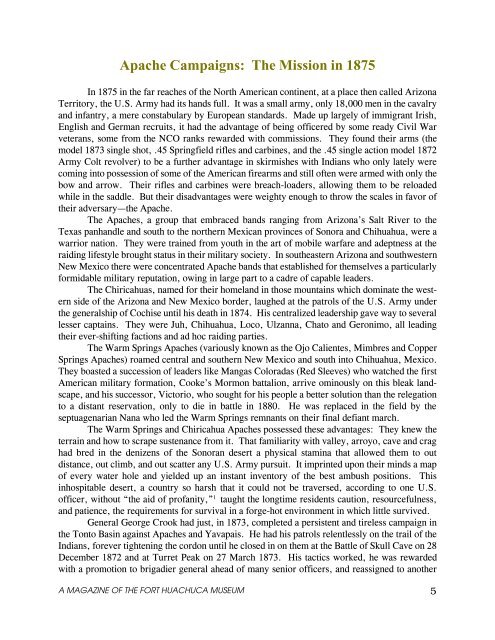Apache Campaigns - Fort Huachuca - U.S. Army
Apache Campaigns - Fort Huachuca - U.S. Army
Apache Campaigns - Fort Huachuca - U.S. Army
You also want an ePaper? Increase the reach of your titles
YUMPU automatically turns print PDFs into web optimized ePapers that Google loves.
<strong>Apache</strong> <strong>Campaigns</strong>: The Mission in 1875<br />
In 1875 in the far reaches of the North American continent, at a place then called Arizona<br />
Territory, the U.S. <strong>Army</strong> had its hands full. It was a small army, only 18,000 men in the cavalry<br />
and infantry, a mere constabulary by European standards. Made up largely of immigrant Irish,<br />
English and German recruits, it had the advantage of being officered by some ready Civil War<br />
veterans, some from the NCO ranks rewarded with commissions. They found their arms (the<br />
model 1873 single shot, .45 Springfield rifles and carbines, and the .45 single action model 1872<br />
<strong>Army</strong> Colt revolver) to be a further advantage in skirmishes with Indians who only lately were<br />
coming into possession of some of the American firearms and still often were armed with only the<br />
bow and arrow. Their rifles and carbines were breach-loaders, allowing them to be reloaded<br />
while in the saddle. But their disadvantages were weighty enough to throw the scales in favor of<br />
their adversary—the <strong>Apache</strong>.<br />
The <strong>Apache</strong>s, a group that embraced bands ranging from Arizona’s Salt River to the<br />
Texas panhandle and south to the northern Mexican provinces of Sonora and Chihuahua, were a<br />
warrior nation. They were trained from youth in the art of mobile warfare and adeptness at the<br />
raiding lifestyle brought status in their military society. In southeastern Arizona and southwestern<br />
New Mexico there were concentrated <strong>Apache</strong> bands that established for themselves a particularly<br />
formidable military reputation, owing in large part to a cadre of capable leaders.<br />
The Chiricahuas, named for their homeland in those mountains which dominate the western<br />
side of the Arizona and New Mexico border, laughed at the patrols of the U.S. <strong>Army</strong> under<br />
the generalship of Cochise until his death in 1874. His centralized leadership gave way to several<br />
lesser captains. They were Juh, Chihuahua, Loco, Ulzanna, Chato and Geronimo, all leading<br />
their ever-shifting factions and ad hoc raiding parties.<br />
The Warm Springs <strong>Apache</strong>s (variously known as the Ojo Calientes, Mimbres and Copper<br />
Springs <strong>Apache</strong>s) roamed central and southern New Mexico and south into Chihuahua, Mexico.<br />
They boasted a succession of leaders like Mangas Coloradas (Red Sleeves) who watched the first<br />
American military formation, Cooke’s Mormon battalion, arrive ominously on this bleak landscape,<br />
and his successor, Victorio, who sought for his people a better solution than the relegation<br />
to a distant reservation, only to die in battle in 1880. He was replaced in the field by the<br />
septuagenarian Nana who led the Warm Springs remnants on their final defiant march.<br />
The Warm Springs and Chiricahua <strong>Apache</strong>s possessed these advantages: They knew the<br />
terrain and how to scrape sustenance from it. That familiarity with valley, arroyo, cave and crag<br />
had bred in the denizens of the Sonoran desert a physical stamina that allowed them to out<br />
distance, out climb, and out scatter any U.S. <strong>Army</strong> pursuit. It imprinted upon their minds a map<br />
of every water hole and yielded up an instant inventory of the best ambush positions. This<br />
inhospitable desert, a country so harsh that it could not be traversed, according to one U.S.<br />
officer, without “the aid of profanity,” 1 taught the longtime residents caution, resourcefulness,<br />
and patience, the requirements for survival in a forge-hot environment in which little survived.<br />
General George Crook had just, in 1873, completed a persistent and tireless campaign in<br />
the Tonto Basin against <strong>Apache</strong>s and Yavapais. He had his patrols relentlessly on the trail of the<br />
Indians, forever tightening the cordon until he closed in on them at the Battle of Skull Cave on 28<br />
December 1872 and at Turret Peak on 27 March 1873. His tactics worked, he was rewarded<br />
with a promotion to brigadier general ahead of many senior officers, and reassigned to another<br />
A MAGAZINE OF THE FORT HUACHUCA MUSEUM<br />
5

















